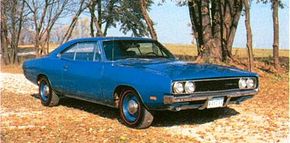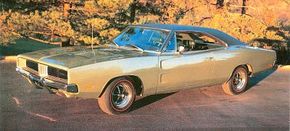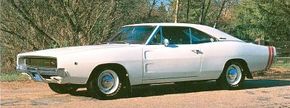After an impressive start-up in 1966, sales of the dramatic fastback Charger slipped in its second season. What to do? Unleash a restyled edition -- the 1968-1969 Dodge Charger models -- with an even tougher stance and extra muscle.
Advertisement
Many considered the revised 1968-1969 Dodge Charger models to be some of the best-looking mid-size cars around, though the original fastback roofline was replaced by a notchback semi-fastback profile with "flying buttress" sail panels.
To satisfy the muscle-car crowd, Dodge released a Charger R/T (for Road/Track) as part of its "Scat Pack," which also included the Coronet R/T and Dart GTS. Each wore bumblebee stripes around its tail and carried an engine appropriate for its title.
Ads for "The Clean Machine" (Charger R/T) noted that it was "not built for the common car crowd." For many, that's all it took to induce an insatiable craving for a 440-Magnum V-8 and hit 'em hard suspension.
Though aimed at "a rugged type of individual," however, Charger ads further noted that the likely buyer was a person "who likes it soft inside." So which was it, ruffian or softy?
Actually, the Charger benefited from a dual personality and qualified on both counts. Vinyl-trimmed bucket seats and posh amenities lured comfort seekers, with a cushion available to position an extra passenger between the buckets.
An aggressive exterior with power to match was enough to pull in the performance boys -- especially when abetted by a pair of pipes blaring out the back, and brawny red-sidewall rubber hitting the pavement.
Hemi and Magnum engines were only part of the story, after all. Standard Charger fittings included a mild-mannered 318-cid V-8 with an adequate, if uninspiring, 230 horsepower. Next step up: Chrysler's 383, with 290 or 330 bhp. Only by ordering an R/T or checking off the 375-bhp Magnum or 425-bhp Hemi did the Charger turn from pussycat into mean machine.
Copywriters for muscle-car ads evidently had a nasty streak, pushing their products' potential antisocial tendencies with forthright abandon. A Charger's suspension, they reported, "treats an angled grade crossing in the rain with studied insolence," while this "Beautiful Screamer" with an "impertinent flip of the spoiler on the rear deck" contained "440 cubes of mean."
Continue reading to find out more about the "antisocial" car of choice for driving enthusiasts.
For more information on cars, see:
- Classic Cars
- Muscle Cars
- Sports Cars
- Consumer Guide New Car Search
- Consumer Guide Used Car Search
Advertisement


